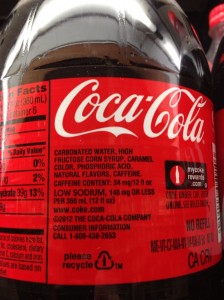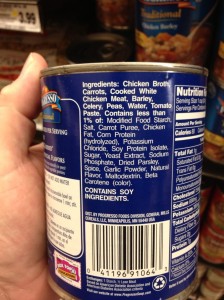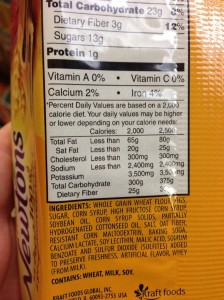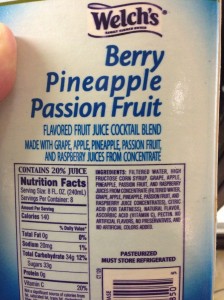Let me make this clear from the outset – high fructose corn syrup is the single largest health hazard since smoking. There is no one product that impacts the lives of so many, and is responsible for the increase in obesity, diabetes, and hypertension.
If there is one common denominator to all diets that work, to all countries that have a low incidence of heart disease it is the consumption of fructose. Fructose, the unified field theory of diet- the General Relativity equivalent for all things that are evil and can cause harm.
The video above, which will be modified and edited over time, demonstrates an analogy of fructose, and how it works with your body in such a way that it causes more than its fair share of problems – but here is some of the facts behind fructose, and things you should know.
Fructose is one half of table sugar. It is the bad half. We didn’t know that for years, but as evidence mounts, it is clear that fructose is not a sugar that humans use primarily, it has to be modified to be used by the body. The more fructose a society consumes, the higher the rate of obesity becomes – and while population studies are notoriously inaccurate, this is one simple fact that is seen over and over again in almost every population.

Drinks like this account for a lot of obesity. In my opinion, they should not be allowed to be served to minors.
Biochemistry of Fructose
When I grew up I was told that fructose was “fruit sugar,” and therefore natural, and good and something that we could think of as the good sugar. Who hasn’t been told to eat their fruits and vegetables? Part of that is true – but lets get to what pure fructose does, not what fructose does when it is complexed with the fiber, and other chemicals found in your fruit.
When you eat sugar, the sugar molecule is quickly cleaved into one molecule of glucose, and one molecule of fructose. This is done in the intestine by enzymes on the surface of the intestine called brush-border cells that cleave the sugar into its two components. Glucose is actively transported into cells. This transport mechanism is given a “heads up” by the “taste buds” in the intestine. Yes, there are taste buds in the intestine, and they look exactly like taste buds in the tongue, and sense “sweetness.” They do not deliver the sense of taste to the brain, but they do release hormones that do two things: tell the active glucose transport cells downstream to increase activity, and tell the pancreas to start producing insulin.
Glucose biochemistry is well worked out- over 80% of the glucose that hits the intestine is used almost immediately. Glucose is the fuel of every cell in the body, and is tightly regulated to store as glycogen in cells, if there is an excess and only a very small per cent of glucose is ever put down the Kreb cycle and complexed with VLDL to become fat – in fact, it is less than one half of one per cent.
Fructose, on the other hand is not used by any cell of the body as fuel. There is no active transport of fructose into the body, because the body cannot use fructose. Instead fructose is diffused through the intestine – in what is called a facilitated diffusion. Fructose in fruit, which is complexed with fiber, amylose, and amylopectin, cellulose, hemicellulose, pectin, gums, and other items – cannot diffuse easily. it remains mostly bound to the fiber. Bacteria that can use fructose as fuel, and inhabit the gut, happily use fructose. Thus, bound fructose has much less of an impact on the body as free fructose.
A large concentration of free fructose, as what happens when a person consumes a lot of sugar, or high fructose corn syrup, is diffused quickly across the intestine’s membranes and into the bloodstream. The body can’t do anything with fructose in the blood, it has to be transformed in the liver. Fructose does not cause insulin levels to rise- and this was once thought to be an advantage, and its lower glycemic index. But it points out how fructose is simply not a useable fuel. Sadly, since fructose looks similar enough to glucose, it does bind with some insulin receptors in a competitive fashion, the end result having two bad effects: it competitively makes cells insulin resistant (more insulin has to be used to get the glucose into cells) and that diminishes appetite suppression (the more fructose you eat, the less suppressed appetite becomes).
The liver is the major organ for fructose metabolism. Fructose is converted to Fructose 1-phosphate by an ATP mediated reaction but this depletes the intra-cellular ATP, which isn’t a good thing. At this point the fructose is modified by aldolase B, and more pathways until there are two paths that fructose can go down: either through glycolysis into pyruvate or gluconeogenesis into glucose.
Here is the rub: when scientists have done the math, 30% of fructose ends up in the pathway that leads to fat and increased levels of triglycerides and VLDL. Compare that with 1/2% of 1 per cent from glucose.
Fructose also in the lipogenic pathway deposits fat- and that fat typically stays in the liver- where it is a part of the fatty liver syndrome. Remember excess glucose becomes glycogen, which is non-toxic to the liver. Fructose becomes fat, and fatty liver can lead to cirrhosis, liver failure, and death.
One other biproduct of fructose metabolism: uric acid. If you overload with uric acid, in this case taking a lot of fructose, it can make joints hurt, or worse if you have gout, and have a modest increase in blood pressure.
High Fructose Corn Syrup
If you read the people who are paid by the corn lobby they will tell you that HFCS is just like sugar, it has fructose and glucose in about equal portions, and that there should not be a fuss about using HFCS, because it is cheaper than sucrose. Besides, they will point out that fructose is just fruit sugar, a natural product.
But what happens when this is tested in the laboratory? Is that bit of extra fructose going to make a difference?
In one study a group of scientists at Princeton fed rats calorie equivalent sugar water and rat chow, and high fructose corn syrup and rat chow. The rats who were fed the HFCS developed obesity- and not just any obesity, but the obesity around the abdomen (visceral fat). Just that bit extra of fructose made a difference.
In another study UCLA scientists found that rats who had omega-3 fatty acid deficiency and fed a high fructose diet did not perform as well. They were a bit fuzzy.
Bottom line: that little bit of extra fructose means something. Sugar isn’t that great, but HFCS is even worse. Increased obesity, increased VLDL production, increased triglycerides, increased fatty liver disease.
When it comes to food labels, I read more for this than any other ingredient.

Even soups use sweeteners
The Math of Fructose
The math of fructose is that 30% of fructose will convert to fat. That is not including any excess calories you have from any other source. To put this in a perspective, if something contains sugar – then half of the sugar is fructose, so 15% of those calories go to fat. If the food product contains high fructose corn syrup then 18 to 20% go to fat.
Added sugar in the average American diet, according to the USDA is 92 pounds of sugar and 64 pounds of high fructose corn syrup. From the fructose alone, that accounts for 13 pounds of fat a year added to the average American. If that average American does that for ten years- they now reach morbid obesity. Where is all that added sugar coming from? Only about 29 pounds of it comes as traditional sugar, or sucrose, according to The Sugar Association, a trade group of sugar manufacturers. That would be the food we can easily account for: candy, soda, and junk food.
Where most people are not looking is the added sweeteners in some crackers (like my beloved Fig Newtons), yogurt, ketchup (my favorite, Heinz has it), and peanut butter, all have added high fructose corn syrup, or some have sugar. High fructose corn syrup consumption, in the US, has increased 3.5% per year since 2000, according to the World Health Organization (WHO).

I use to think these were a healthy snack – turns out they are just a vehicle for sugar
The hidden calories are also found in “low fat” items. Fat makes food taste good- so to get rid of fat from the diet, food makers add more sweeteners. Beware of the low-fat items.
Its not the calories, its what your body does with them
For years people have said- reduce calories to lose weight. But it isn’t just the calories- because calories are an indirect measure. A calorie is actually a term used by physics, and does not account for the biochemistry of the body. It really is what your body does with the calories. When a third of the fructose you eat goes directly into making fat, and artery clogging VLDL, no matter how you slice it, fructose is a major problem.
So a calorie is not just a calorie, and calorie counting doesn’t work when it comes to fructose. Humans are just not wired to eat fructose.
But it’s Fruit Sugar
There is a big difference between sugar that is complexed in a fruit and sugar that is refined and processed and away from things. When you eat a pear, or an orange, the fructose sugar in it is complexed with fiber. That isn’t refined fructose that is passively diffused across the intestine, it is complexed with fiber that cannot be absorbed. Fructose from fruit is ok. But take that fiber away, as in fruit juices, and you now you are starting to free the fructose so it can be absorbed into your blood stream and do its work.
Avoiding commercial fruit juices is a way to avoid more refined fructose. Plus a lot of fruit juices, like Welch’s juice, add things like high fructose corn syrup (it is their second listed ingredient).

Most juice companies use corn syrup to sweeten their product
Diets and Fructose
Today we have the paleo-diet: our modern version of the low-carbohydrate diet. More than anything, this diet limits fructose.When you look at the common diets available today, and in the years past, you will see all limited or eliminated fructose. There have been a variety of protein diets – all saying sugar was evil, but was it sugar – or was it the fructose.
We also have the Mediterranean Diet – there is glucose in it, but there is not fructose.
You have the strict vegans: fructose is certainly in the fruits, as it is with many diets- but we are talking about refined fructose, away from its fiber.
Population Studies
Ever wonder why France consumed all that fat and stayed healthy? Well, until recently there was little fructose in their diet. Ever wonder how Italians ate pasta and didn’t gain much weight – well, until recently they didn’t have much fructose in their diet. Ever wonder how people in China ate all those noodles and remained slim? Well, they didn’t have a lot of fructose in their diet. The sad reality is that with our increased production of corn we are exporting more high fructose corn syrup to these countries, and they are seeing more and more obesity. Population studies are flawed – and we have discussed that before, but it is more than co-incidence that as the fructose in the diet increases so does obesity — it is science.
Obesity and Children:
Obesity among kids is on the rise, and it is getting worse. We have already reported that children who attend schools that have strict rules about junk food have less likelihood of being obese. You can see that report here. We regulate alcohol sold to children, we don’t let kids buy tobacco, so why do we let them purchase drinks that have added sugar or added high fructose corn syrup. If the adult wants to buy them, and supervise them with this, that is fine -but it is time to regulate this product. There is no reason to allow children to purchase this food. And if we label it and make it harder for kids to buy, guess what- adults will think twice about it.
High Fructose Corn Syrup is today’s equivalent of the smoking epidemic
Years ago there was an outcry about cigarettes, and the health risks of smoking. As a result, many people have stopped smoking and are living a better lifestyle. But today the risk to health is high fructose corn syrup. It is the major public health hazard of this century.
One thing
So if you could do one thing- get rid of one thing, it would be getting rid of fructose in your diet, except for that which comes in whole plants. If you want to blend fruit in a smoothie- that is fine also.
People who make their own food – bake their own bread, make their own pasta sauce, cook their own meals are less obese, and appreciate food more.
REFERENCES:
The below study showed ” Fructose area under the curve and maximum concentration, dose-normalized glucose area under the curve and maximum concentration, relative bioavailability of glucose, changes in postprandial concentrations of serum uric acid, and systolic blood pressure maximum levels were higher when HFCS-sweetened beverages were consumed as compared with sucrose-sweetened beverages. Compared with sucrose, HFCS leads to greater fructose systemic exposure and significantly different acute metabolic effects”
Effects of high-fructose corn syrup and sucrose on the pharmacokinetics of fructose and acute metabolic and hemodynamic responses in healthy subjectsLe MT, Frye RF, Rivard CJ, Cheng J, McFann KK, Segal MS, Johnson RJ, Johnson JA.Metabolism. 2012 May;61(5):641-51. Epub 2011 Dec 5. PMID: 22152650
The effects of high fructose syrup.Moeller SM, Fryhofer SA, Osbahr AJ 3rd, Robinowitz CB; Council on Science and Public Health, American Medical Association.J Am Coll Nutr. 2009 Dec;28(6):619-26. PMID: 20516261
Does fructose consumption contribute to non-alcoholic fatty liver disease? Tappy L, Lê KA J Am Coll Nutr. 2009 Dec;28(6):619-26 PMID: 22795319
Great rat study comparing sucrose with HFCS. They concluded “This increase in body weight with HFCS was accompanied by an increase in adipose fat, notably in the abdominal region, and elevated circulating triglyceride levels. Translated to humans, these results suggest that excessive consumption of HFCS may contribute to the incidence of obesity.”
High-fructose corn syrup causes characteristics of obesity in rats: increased body weight, body fat and triglyceride levels. Bocarsly ME, Powell ES, Avena NM, Hoebel BG.Pharmacol Biochem Behav. 2010 Nov;97(1):101-6. PMID: 20219526
The below study showed: ” A 7-d high-fructose diet increased ectopic lipid deposition in liver and muscle and fasting VLDL-triacylglycerols and decreased hepatic insulin sensitivity. Fructose-induced alterations in VLDL-triacylglycerols appeared to be of greater magnitude in the OffT2D group, which suggests that these individuals may be more prone to developing dyslipidemia when challenged by high fructose intakes”
Fructose overconsumption causes dyslipidemia and ectopic lipid deposition in healthy subjects with and without a family history of type 2 diabetes. Lê KA, Ith M, Kreis R, Faeh D, Bortolotti M, Tran C, Boesch C, Tappy L. J Clin Nutr. 2009 Jun;89(6):1760-5.
Below are some of the same references from my book, with our added commentary. Our book, coming in the spring of 2013 (we hope) is called:
JUST EAT! Recipes from a surgeon Shattering myths about food from a weight loss doctor that knows your body inside and out
the fun part of the book has been the reference area- which has more “nerdy” stuff:
Fructose may be more of a problem than we thought. When people are placed on a high fructose diet there is an increase in fat deposited in the liver, an increasing level of VLDL – very low density lipoproteins, which is major risk factor for heart disease, and increased insulin resistance. The increase in uric acid deposition is one of the reasons that when some people get “off sugar” their joints feel better. High Fructose Corn Syrup is sweeter than table sugar, and contains more fructose (fructose tastes sweeter). It is not the “equivalent” of sugar, and that extra fructose adds to the problems. When rats are fed diets that use HFCS instead of sugar, they gained more weight, more weight in the abdomen, and increased levels of serum triglycerides. In another study, rats who were deficient in omega-3 fatty acids but fed on a high fructose diet did not repair their brain as well. So when the corn industry says that high fructose corn syrup is about the same as table sugar I have two answers: (a) no one said that table sugar is good for you and (b) the studies are clear that the extra bit of fructose in high fructose corn syrup has a bad effect on people’s weight, heart, and brain. Cooking your own food, relying less on processed foods, means you won’t have this in your diet. Think about it this way: that extra fructose you have per day may not be much, but it adds up. Drinking one 48 ounce sugar filled drink a day leads to 10 pounds in a year of fat from fructose alone, or two 12 ounce cans leads to 5 pounds a year. That is just fat- not the extra calories that your may store with it. Add the high fructose corn syrup up in all you eat, and it is easy to see small weight gain over the year.
Am J Clin Nutr 2009 Pub Med ID 19403641 Pharmacol Biochem Behav 2010 Pub Med ID 20219526
There is an increasing worry among some that the high fructose corn syrup, which has replaced sucrose (table sugar) in many processed foods is responsible for obesity. Consumption of any caloric sweeteners, including table sugar and high fructose corn syrup needs to decrease. Long term studies continue to show the impact of fructose on our health J Am Coll Nutr 2009 Pub Med ID 20516261 Many will say fructose is just “fruit sugar,” and make the statement that it is good for you. There is a difference between refined fructose, and eating a grapefruit. When you eat a grapefruit the amount of fructose that is bioavailable is far less than when you eat refined fructose (as in sucrose or high fructose corn syrup). The fructose in a fruit is bound to fiber, and thus less is available to you. When tested HFCS has higher fructose concentration than sucrose
Metabolism 2012 Pub Med ID 22152650
A review article about fructose and how the refined version has correlated with the risks of obesity, diabetes, and cardiac disease.
J Diabetes Sci Technol 2010 Pub Med ID 200663467
Fructose contributes to fat in the liver – sometimes we call it fatty liver disease. This is more than a cosmetic issue, as fatty liver can progress to fibrosis which is scar, and this is cirrhosis. Fatty liver has now become the number one cause for needing liver transplants. Daily fructose ingestion was found to lead to increase fibrosis (scaring or cirrhosis) of the liver. Hepatology 2010 Pub Med ID 20301112 As High Fructose Corn Syrup goes into the western world there is an increase in type 2 diabetes that is independent of obesity. As China is getting fatter, and other countries, the one factor that has changed is (a) more restaurants from America and (b) more high fructose corn syrup
Glob Public Health 2012 Pub Med ID 23181629
